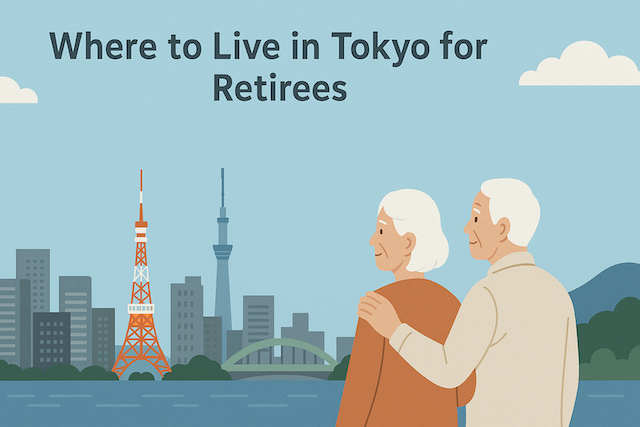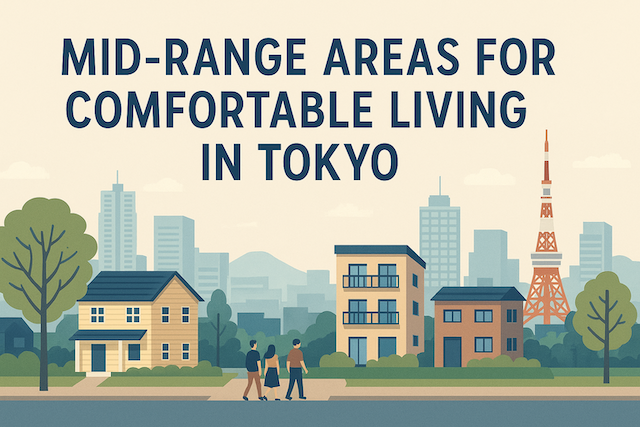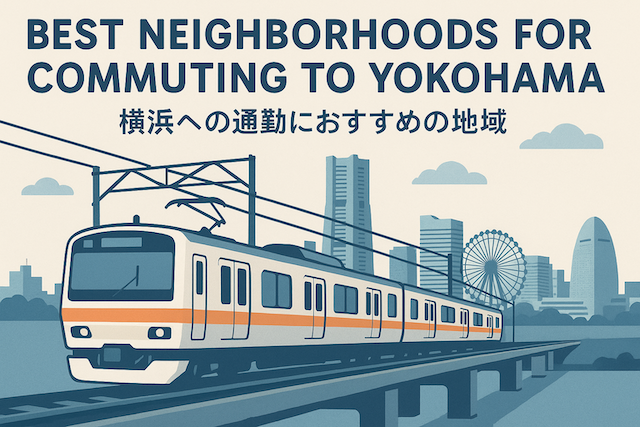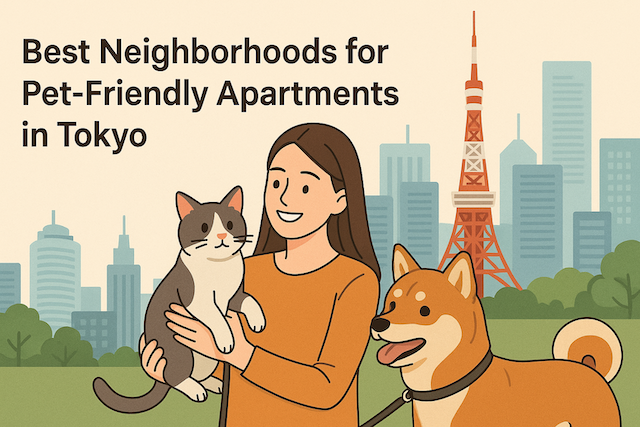Where to Live in Tokyo for Retirees
Tokyo, Japan’s bustling capital, is often seen as a city for students, professionals, and tourists. Yet, it’s also a surprisingly comfortable and enriching place for retirees. With world-class healthcare, excellent public transportation, safe neighborhoods, and abundant cultural activities, Tokyo offers an ideal environment for seniors seeking an active and convenient retirement life. This guide explores the best areas to live in Tokyo for retirees, covering lifestyle, comfort, healthcare access, and local community atmosphere.
Why Retire in Tokyo?
Tokyo may seem fast-paced, but its structure and services make life easier for retirees. The city is exceptionally safe, clean, and well-connected. Most residential neighborhoods have convenient access to hospitals, parks, supermarkets, and public transport.
Key benefits include:
-
Top-tier healthcare: Tokyo’s hospitals are among the best in Asia, with many English-speaking doctors.
-
Convenience: From groceries to pharmacies, everything is within walking distance or a short train ride.
-
Public safety: Tokyo consistently ranks among the safest cities in the world.
-
Culture and leisure: Temples, museums, community centers, and hobby clubs are easily accessible.
For retirees who wish to stay engaged, Tokyo offers both peaceful living and endless opportunities to explore.
Best Neighborhoods for Retirees in Tokyo
1. Meguro – Tranquil and Convenient
Meguro offers a quiet, green, and upscale environment while remaining close to central Tokyo. The area’s Meguro River and parks create a serene atmosphere perfect for daily walks.
Meguro Station provides easy access to Shibuya, Shinagawa, and Yokohama, making transportation stress-free.
Why it’s ideal:
-
Excellent hospitals like Tokyo Metropolitan Hiroo Hospital nearby.
-
Abundance of cafes, restaurants, and small stores.
-
Calm yet central—great for retirees who enjoy balance.
2. Setagaya – Peaceful Residential Charm
Setagaya is Tokyo’s largest ward and known for its suburban comfort. It has a strong sense of community and many parks, including Komazawa Olympic Park and Setagaya Park.
The area’s quiet streets, local shops, and family-oriented vibe appeal to retirees who want a relaxed daily rhythm.
Why it’s ideal:
-
Spacious housing options and greenery.
-
Local clinics and easy access to major hospitals.
-
Cultural centers offering art classes and social events.
3. Kichijoji (Musashino City) – Lively but Relaxed
Kichijoji often tops “most desirable places to live” lists in Japan. It combines a peaceful park life with urban convenience. Inokashira Park provides beautiful walking paths, ponds, and nature scenes year-round. The neighborhood has boutiques, traditional cafes, and community events that keep retirees socially active.
Why it’s ideal:
-
Close to nature but still urban.
-
Compact and walkable area.
-
Rich in art and music culture.
4. Jiyugaoka (Meguro/Setagaya Border) – European Feel and Relaxed Living
Jiyugaoka’s charming streets, Western-style cafes, and quiet atmosphere attract retirees who value both sophistication and peace. The district has boutique shops, cozy restaurants, and plenty of medical facilities nearby.
Why it’s ideal:
-
Clean, flat streets easy for walking.
-
Upscale but not crowded.
-
Great access to central Tokyo through the Tokyu Line.
5. Nakameguro – River Views and Café Culture
Nakameguro offers stylish comfort for retirees who enjoy active city life without the chaos of Shibuya. The Meguro River Cherry Blossoms make springtime enchanting, and local restaurants are among the city’s best.
Why it’s ideal:
-
Beautiful walking environment.
-
Quiet evenings, lively days.
-
Close to hospitals and supermarkets.
6. Koenji (Suginami Ward) – Affordable and Friendly Community
Koenji has a nostalgic Tokyo charm and a warm community spirit. Retirees looking for a more affordable area with a neighborhood feel will enjoy it here. The area’s shopping arcades and small local eateries make daily life convenient and social.
Why it’s ideal:
-
Lower rent and living costs.
-
Local events and vintage shops.
-
Relaxed, bohemian atmosphere.
7. Tama Area (Tama City, Hachioji, Machida) – Suburban Comfort
For retirees preferring quiet, spacious living surrounded by greenery, Tokyo’s western suburbs are excellent choices. Areas like Tama City and Hachioji have modern infrastructure, wide streets, and easy access to hospitals and large shopping centers.
Why it’s ideal:
-
Affordable housing options.
-
Cleaner air and more space.
-
Strong local communities and senior-friendly facilities.
Healthcare Access for Retirees
Tokyo’s healthcare system is world-class, and retirees can easily find both public and private hospitals. International residents often use facilities like:
-
Tokyo Midtown Medical Center (Roppongi)
-
St. Luke’s International Hospital (Tsukiji)
-
Juntendo University Hospital (Bunkyo)
Most clinics accept Japan’s National Health Insurance (NHI). Pharmacies are located in every neighborhood, and home delivery of medicine is becoming more common.
Cost of Living for Retirees in Tokyo
Tokyo is known for being expensive, but careful budgeting makes retirement life comfortable.
Monthly estimate (single retiree):
-
Rent (1BR apartment): ¥100,000–¥180,000
-
Utilities: ¥15,000–¥25,000
-
Groceries: ¥40,000–¥60,000
-
Healthcare & Insurance: ¥20,000–¥30,000
-
Leisure & Transport: ¥20,000–¥40,000
Total: Around ¥200,000–¥330,000 per month, depending on lifestyle and location.
Suburban areas like Setagaya or Tama can reduce expenses by 20–30%.
Social and Leisure Activities
Tokyo offers countless activities for retirees who wish to stay active:
-
Community centers offering fitness classes, language lessons, and crafts.
-
Volunteer opportunities at libraries, schools, and NGOs.
-
Cultural hobbies like tea ceremony, calligraphy, or gardening clubs.
-
Parks and temples perfect for meditation or morning walks.
Retirees also benefit from Japan’s extensive train system for easy day trips to nearby spots like Kamakura, Hakone, or Nikko.
Safety and Accessibility
Tokyo’s infrastructure makes life easier for seniors. Most train stations now have elevators, escalators, and accessible restrooms. Pedestrian crossings are safe and well-lit, and crime rates are among the lowest globally.
Neighborhood police boxes (kōban) provide immediate help if needed. Local governments also organize support programs for elderly residents living alone.
Final Thoughts
Tokyo is not just for the young — it’s a city that respects and supports retirees through world-class healthcare, clean living environments, and an active cultural scene. Whether you prefer the green tranquility of Setagaya, the suburban calm of Tama, or the balanced lifestyle in Meguro, there’s a perfect corner of Tokyo for every kind of retiree.
Choosing where to live depends on what you value most: convenience, affordability, or nature. But in every case, Tokyo offers something few global capitals can — a peaceful, fulfilling, and safe life even in your golden years.
FAQs
What makes Tokyo a good place for retirees?
Tokyo pairs world-class infrastructure with low crime, reliable public transit, abundant parks, and superb healthcare access. Daily needs—groceries, pharmacies, clinics, ATMs—are typically within a short walk of most stations. Cultural life is rich and varied, from museums and libraries to hobby circles and volunteer opportunities. While the city is dynamic, many residential neighborhoods are quiet, clean, and senior-friendly, offering elevators in stations, barrier-free sidewalks, and well-marked crossings.
Which Tokyo neighborhoods are most retiree-friendly?
Several areas balance calm streets, greenery, and quick access to major hubs:
- Meguro/Jiyugaoka: Leafy, walkable, and central, with plenty of cafes and clinics.
- Setagaya: Residential comfort, parks (e.g., Komazawa), and strong community clubs.
- Kichijoji (Musashino): Inokashira Park, lively shopping streets, and a small-town feel near the city.
- Nakameguro: Flat, riverside walks and a gentle pace close to top hospitals and supermarkets.
- Koenji (Suginami): Friendly shotengai (local arcades), good value, and laid-back charm.
- Western suburbs (Tama, Hachioji, Machida): Larger homes, quieter streets, and big medical centers.
How much does it cost to live in Tokyo as a retiree?
Costs vary by lifestyle and location, but many retirees find a comfortable range with careful budgeting. Typical monthly outlays might include rent for a one-bedroom apartment, utilities, groceries, transit, healthcare, and leisure. Central wards command higher rents, while suburban areas tend to be 15–30% cheaper. Choosing a place near your regular hospital and preferred transit line can reduce both time and incidental costs over the long term.
Is healthcare accessible and senior-friendly?
Yes. Tokyo offers high-quality hospitals and neighborhood clinics, many with experience serving older adults. Facilities commonly feature ramps, elevators, and multilingual support at larger institutions. Pharmacies are ubiquitous, and prescription delivery services are increasingly common. If you enroll in the national or a private insurance plan as eligible, out-of-pocket costs are generally predictable. Consider selecting housing along a reliable rail line to your preferred hospital for routine checkups and quick access.
Do I need to speak Japanese to live comfortably?
Basic Japanese makes everyday life smoother—especially at clinics, city offices, and small shops—but many retirees do well with a mix of simple phrases, translation apps, and English-speaking services in larger hospitals. Community centers often host language classes tailored for newcomers. Posting polite phrases, medication names, and your address on a wallet card can help in emergencies. Over time, even limited Japanese fosters stronger connections with neighbors and local shopkeepers.
How senior-friendly is public transportation?
Tokyo’s transit is a major advantage. Stations commonly feature elevators, escalators, accessible ticket gates, and clear signage. Trains run frequently and on time, and many buses kneel for easier boarding. Consider living within an easy, flat walk of a station with an elevator; this small choice pays daily dividends. If you use mobility aids, test your commute at non-peak times first to confirm elevator locations and platform layouts.
What housing features should retirees prioritize?
Look for a barrier-free (step-free) entry, elevator access if above the first floor, a walk-in shower or low-threshold bath, and strong natural light. Proximity to a supermarket, pharmacy, clinic, and station can be more valuable than square footage. In wood-frame buildings, higher floors may be quieter. Concrete buildings often provide better sound insulation and earthquake resilience, though they may cost more. If possible, visit at different times of day to check noise, light, and foot traffic.
How does renting work for foreign retirees?
Expect an application with income or asset verification, a copy of your ID/residence card (if applicable), and often a guarantor or guarantor company (with a fee). Move-in costs can include deposit, key money, agency fees, and first month’s rent. Some serviced or “foreign-friendly” rentals simplify this process at a premium. If stairs are challenging, confirm elevator access and unit location in writing before signing.
Are there social and community opportunities for seniors?
Yes—plenty. Ward community centers provide hobby clubs (calligraphy, ceramics, tai chi), low-cost fitness classes, lectures, and volunteer matching. Libraries host talks and foreign-language meetups. Many temples and NPOs welcome volunteers for events, food drives, and cultural programs. Joining a walking group, gardening circle, or arts class is an easy way to build a supportive local network.
What about safety and emergencies?
Tokyo is one of the safest large cities. Keep basic emergency numbers handy and store your address, medications, and an emergency contact on a card in your wallet and phone. Most wards provide multilingual disaster guides, evacuation maps, and alerts. Consider a small “go bag” with water, snacks, a flashlight, medication copies, and a portable phone battery. Choosing a building with strong earthquake standards and a secure bookcase/fixture setup enhances safety.
Can retirees access discounts or benefits?
Depending on your status and age, you may be eligible for transit discounts, community center pricing, pool/gym passes, and museum concessions. Local wards often offer senior wellness programs, health screenings, and fall-prevention workshops. Ask at your ward office or community center for a booklet of senior services, eligibility criteria, and how to apply.
Are pets feasible for retirees in Tokyo apartments?
Yes, if you choose a pet-friendly building. Many condominiums and rentals allow small pets with rules on size, noise, and common-area etiquette. Pet deposits or cleaning fees may apply. Proximity to a vet clinic and a nearby park for daily walks can make pet ownership more convenient and enjoyable.
How can I reduce loneliness and stay active?
Design a weekly rhythm: morning walks in a nearby park, a class at the community center, a volunteer shift, and a hobby afternoon in a café. Establish “regular” spots—a bakery, greengrocer, or tea shop—where friendly faces become routine. Schedule health checkups and social calls on the same day to bundle errands and add pleasant milestones to the calendar.
What’s a sensible first-week plan after moving in?
- Register your address and confirm health insurance details as required.
- Identify your nearest clinic, hospital, pharmacy, and elevator-equipped station exit.
- Map a flat, safe walking route and a rainy-day alternative.
- Visit the ward community center to collect program schedules.
- Test your home safety: smoke alarms, earthquake kit, medication storage, and non-slip mats.
How do seasons and climate affect daily life?
Summers are humid; prioritize an apartment with good ventilation and air conditioning. Spring and autumn are ideal for park walks and day trips. Winters are cool rather than severe; many homes rely on electric or gas heating. Keep a light raincoat and compact umbrella by the door for unexpected showers. If heat bothers you, choose a neighborhood with abundant trees and shaded sidewalks.
What if I have limited mobility or a chronic condition?
Focus on “15-minute living”: a flat route to a station with an elevator, a nearby supermarket and pharmacy, and a clinic you trust. Consider buildings with on-site managers (or a reliable agency contact) and delivery-friendly entryways. Many supermarkets and pharmacies offer delivery; learn their apps early. For appointments, traveling outside rush hours improves comfort and reduces crowd stress.
How can I compare two candidate neighborhoods?
Create a simple scorecard for each: walking difficulty (flat vs. hilly), elevator availability at the nearest station, travel time to your hospital, distance to essentials (pharmacy, supermarket), noise level at night, and community offerings. Do a “life rehearsal”: shop for groceries, ride to the clinic, sit in the local park, and time the door-to-door journey. Small frictions you feel during this test will be magnified in daily life—let them guide your choice.
What documents and habits improve day-to-day ease?
- A wallet card with your name, address, medications, allergies, and an emergency contact.
- Photocopies of key documents stored separately at home.
- A weekly checklist (medicine refill, bill payments, class times, social calls).
- Phone bookmarks for translation, navigation, transit status, and clinic portals.
Bottom line: how do I choose where to live?
Start with your health and routine. Select a neighborhood that shortens essential trips, minimizes stairs, and offers calm, walkable streets. From there, weigh budget, space, and lifestyle perks—parks, cafés, classes, and a hospital you trust on a single rail line. In Tokyo, the right micro-location can transform daily life: a few minutes saved, a gentler walk, and a friendly shopkeeper you greet by name. That combination is what makes the city especially welcoming for retirees.







